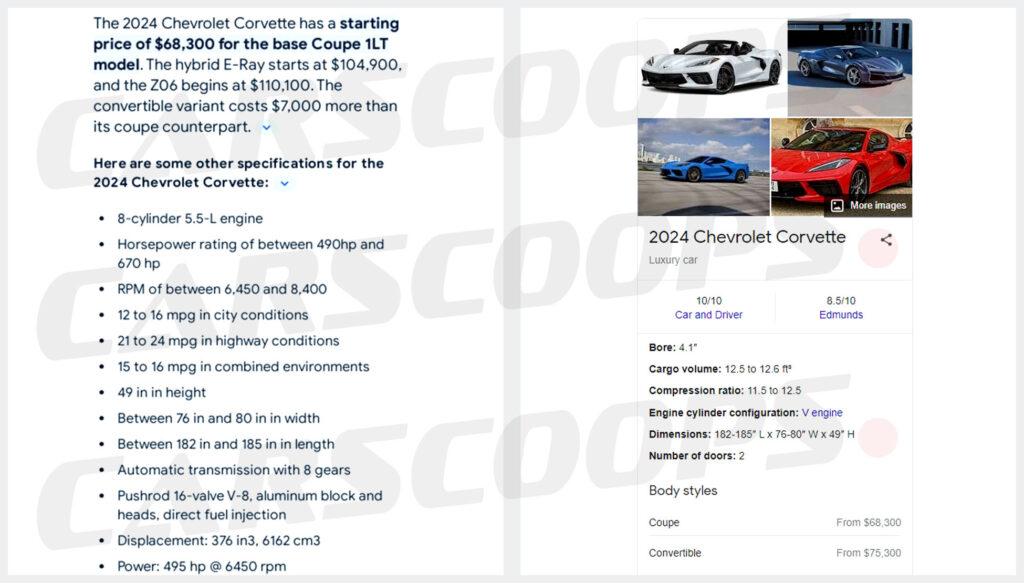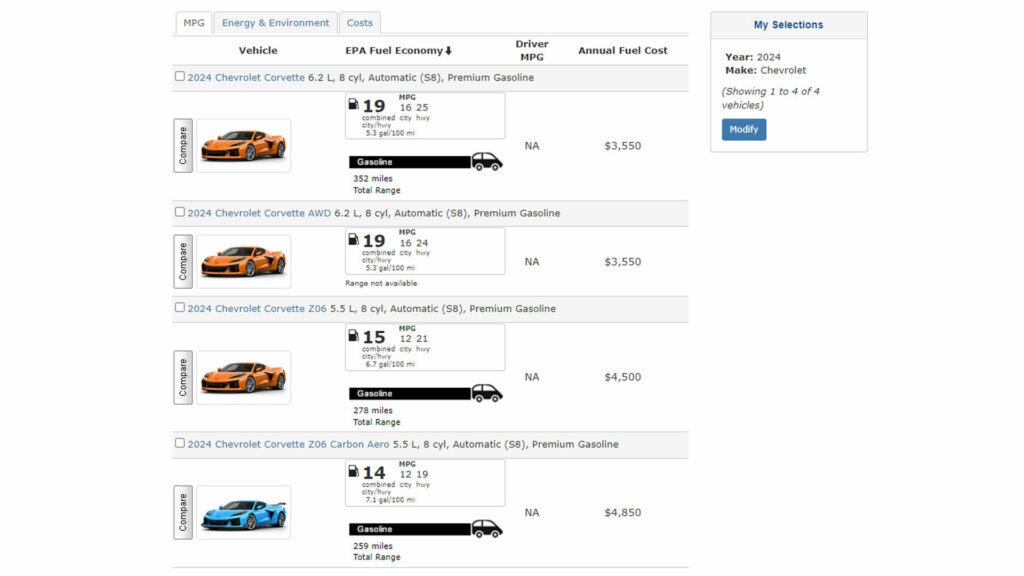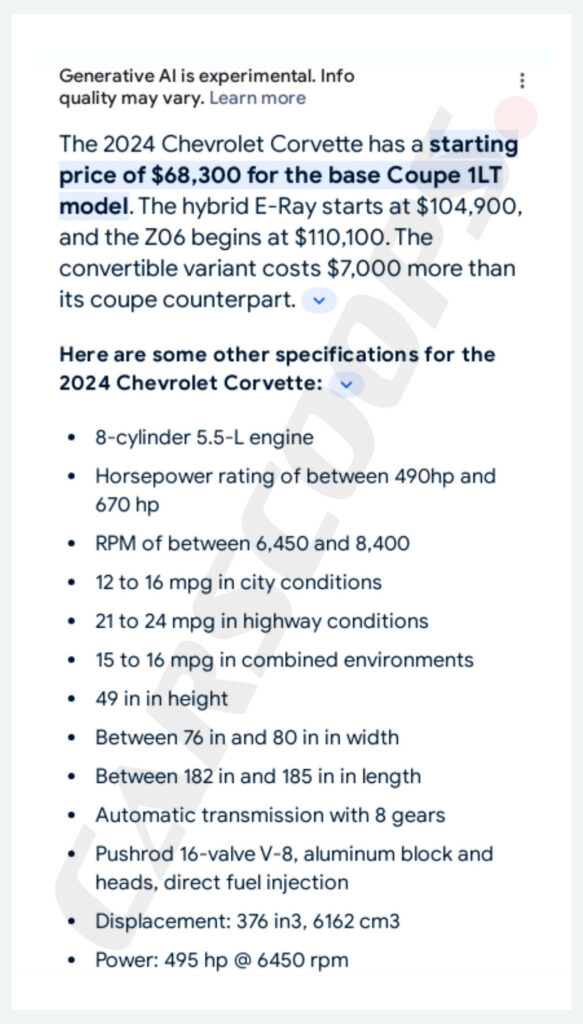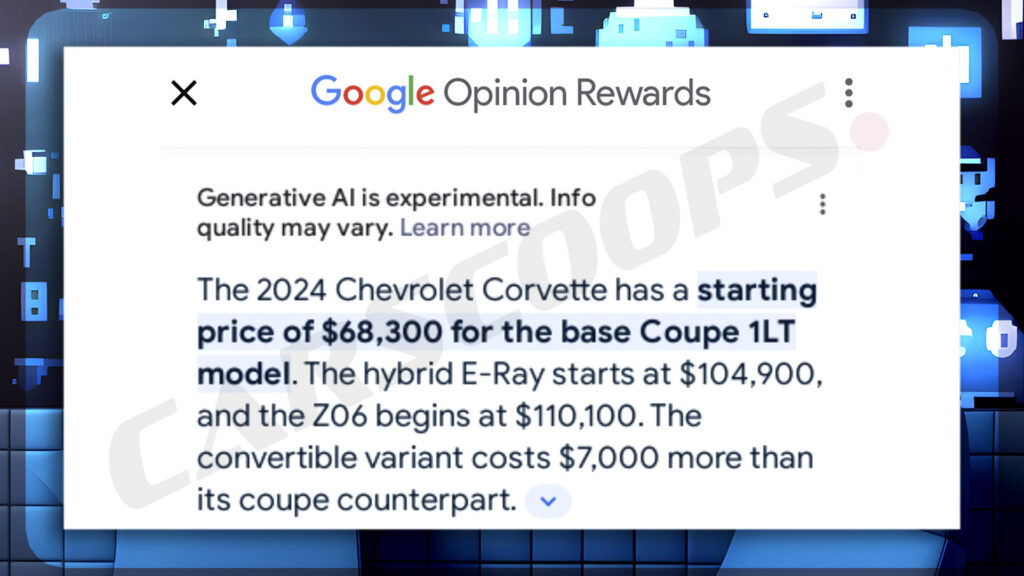When you search for a car on Google, you’ll be treated to lots of ads, links, and an information box providing details about the vehicle. That could change in the future as the search giant is looking at using artificial intelligence (AI) to write short summaries.
The effort was revealed by Google Opinion Rewards and it provides a possible glimpse into the next-generation of search. However, it’s a clunky and incorrect future judging by the example.
The AI correctly listed the base price of the 2024 Corvette Stingray and E-Ray, before destination, but Z06 pricing is confusing as it excludes both the $2,600 gas guzzler tax as well as the $1,695 destination fee. We had to do a double take as Chevrolet lists the model as starting at $111,795 and $112,700.
More: Google Maps Uses AI To Create Immersive View Of Where You’re Going, And To Improve Routing

Google’s AI-written example on the left vs current Corvette search results on the right
Speaking of confusing, the AI says the Corvette has an “8-cylinder 5.5-L engine.” It also mentions a “pushrod 16-valve V-8, aluminum block and heads, direct fuel injection” engine with a displacement of “376 in3, 6162 cm3.”
The latter is a reference to the 6.2-liter V8 that’s used in the Corvette Stingray and E-Ray, but it’s a ham-fisted description. However, the bigger issue is engine information should be grouped together, specified, and written in a consistent style. Instead, the AI lists one displacement in liters and another in cubic inches.
Horsepower ratings are listed as 495 hp and “between 490hp and 670 hp.” Here, the AI seems to be having problems coping with the Stingray’s optional performance exhaust, which increases the output of the 6.2-liter V8 from 490 hp to 495 hp.
Elsewhere, Mr Roboto calls the dual-clutch eight-speed gearbox an “automatic with 8 gears.” That’s kind of how a non-car person might describe it.
Worse, the editor in me is enraged by measurements listed as “80 in in width” and “185 in in length.” Even an occasional butcher of the English language, such as myself, would know to write “185 in. in length” or ideally “185 inches in length.” That being said, at least the measurements are correct, although rounded up.

The correct fuel economy numbers for the Corvette lineup
The same can’t be said about fuel economy ratings as they’re bogus. The city numbers are fine, but the highway figures are wrong at both the high and low end. The EPA lists the 2024 Corvette Stingray as getting 25 mpg highway, which is 1 mpg more than what the AI says. The ‘ghost writer’ also forgot about the Corvette Z06 with the Carbon Aero Package, which is rated at 19 mpg highway and not the 21 mpg listed. It’s also wrong about combined fuel economy as the car actually returns between 14 and 19 mpg, not “15 to 16 mpg.”
While automakers and journalists make mistakes, this is a disappointing showing for Google as there’s a mix of incorrect or missing information, weird wording, and an inconsistent style. Nuance also plays a huge role and that attention to detail is largely absent, resulting in a confusing mess of specs.
More alarmingly, Google didn’t seem to notice or care about the mistakes. Instead, the company was focused on the wording and tone of “starting price of $68,300 for the base Coupe 1LT model.” It’s a little janky and humans would probably rewrite the sentence to say, “The 2024 Chevrolet Corvette Stingray 1LT Coupe has a starting price of $68,300.”
With all that being said, it’s important to note this is only one example and Google clearly stated “generative AI is experimental” and “info quality may vary.” However, the company should know better especially after their disastrous AI misadventure earlier this year.





